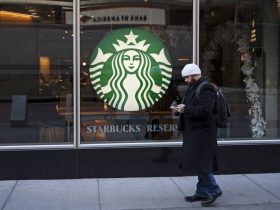The U.S. government said that prices for consumers inched higher in November, but that the pace of inflation continued to slow from last year.
The Bureau of Labor Statistics released its consumer price index Tuesday morning. It said that overall prices for urban consumers rose 0.1% in November compared with October.
The agency said gasoline prices fell sharply and, overall, energy prices are down 9.8% over the last year. But in November, that was canceled out by greater costs for shelter. Those prices are up 6.5% in the last year.
Shoppers in the Magnificent Mile shopping district of Chicago on Dec. 2, 2023. Taylor Glascock / Bloomberg via Getty Images
‘The best news for consumers right now is on gas prices, which have fallen in late 2023 as domestic oil production hit a new record high,’ said Bill Adams, chief economist for Comerica Bank, told NBC News. ‘The biggest sore point for consumers is food, which is at a record high, and shelter prices, where inflation is high as measured by CPI.’
The results were similar to expectations. Economists had projected the data would show that overall prices were unchanged in November compared with October.
The government said that excluding the volatile costs of food and energy, “core” prices rose 0.3%. That matched economists’ estimates.
“Though this would represent an acceleration at the core relative to October, we see this as mainly coming from a reversal in the volatile lodging away from home category,” a team of economists from Bank of America wrote this month, referring to travel and hotel accommodations in its estimation.
Compared with November 2022, the Bureau of Labor Statistics said that prices were up 3.1% and core prices rose 4.0%.
Economists expected a 3.0% increase in the overall price index, and a 4% increase in the core categories.
That’s a bit slower than the inflation reflected in October’s prices, as last month the CPI was up 3.2% over the previous year. And core prices were the same at 4%.
Inflation has been slowing gradually in recent months after it spiked to a 40-year high of 9.1% in June 2022. While slower inflation means the prices of many goods are still going up, the more gradual pace makes it easier for consumers to adjust, and for increased wages to help counteract the financial pain that inflation causes.
There are some signs that consumers are feeling better about the state of the economy as inflation cools off, even though they’re feeling pressure from high credit card interest rates and high housing costs.
If inflation does hold steady or continues to fade, it’s more likely the Federal Reserve will keep interest rates where they are instead of raising them further. The Fed, which will make its last interest rate call of the year Wednesday, sharply raised rates from early 2022 to mid-2023 to try to contain inflation.
That’s the reason interest rates on items such as credit cards and mortgages have increased so quickly over the last year and a half. But as investors and experts think that the Fed might not raise rates again in the near future, their expectations for long-term rates have started to come down. And in turn, that’s brought mortgage rates down a bit recently.
According to the government-backed lender Freddie Mac, the rate on a 30-year fixed-rate mortgage is now about 7%, down from around 8% in early October.
Adams said the Fed could start to reduce interest rates in mid-2024, but that it won’t hurry to do so.
‘After missing their inflation target badly in 2021 and 2022, the Fed would rather hold rates high for longer than necessary than cut too early and see inflation pick back up again,’ he said.










